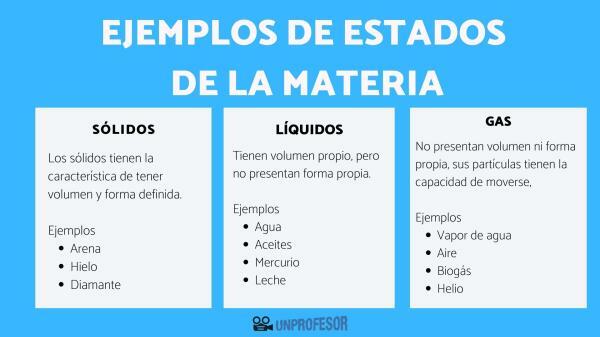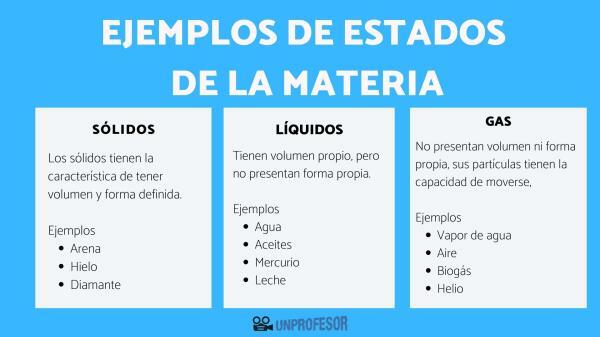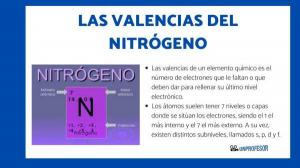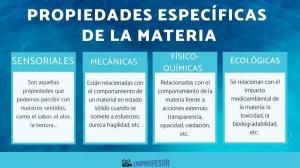Solid, liquid, gaseous state

exist 3 states of organization of matter: the solid state, liquid state and gaseous state. The difference between them is due to the kinetic energy and the distance between the particles. Next, in this article today we are going to describe the solid, liquid, gaseous state that exist in nature, their characteristics and examples of each of them.
Index
- What are the states of matter
- solid state examples
- Liquid state: examples
- Examples of gaseous state of matter
What are the states of matter.
There are two types of forces between the particles that make up the different states of matter: forces of attraction and forces of repulsion.
- In it gaseous stateThe forces of repulsion tend to be stronger than those of attraction and, in turn, they present continuous movement, therefore the particles are more separated and more dispersed.
- In it solid state attractive forces predominate, therefore the particles are closer to each other and present less movement.
- Heliquid state It is an intermediate point between both states, since the particles are neither very close nor very far, and they present a certain fluidity or movement.
In turn, either by adding or removing energy, materials can change state, that is that is, from the solid state they can go to the liquid state and from the liquid state to the gaseous state and vice versa.

Examples of solid state.
Solids have the characteristic of having volume and definite shape.. This is due to the fact that the particles are located in an orderly manner and that they have very little space between them, which is why they are characterized by not being comprehensible, that is, they cannot be compressed. They are also not able to flow, unlike liquids and gases that can. But they do have the ability to expand when subjected to high temperatures.
examples
- Sand: It is composed of small mineral grains detached from rocks that gather on the banks of rivers and seas.
- Ice: when water in a liquid state is subjected to very low temperatures it becomes a solid state, this is called ice.
- Diamond: It is the solid that presents greater hardness, it is composed of crystallized carbon.
- And so: It is Calcium sulfate semihydrate, it is an industrial product that is usually used for construction. It is marketed ground, in powder form and by adding water it solidifies.
Liquid state: examples.
The liquid state presents intermediate characteristics between both states.. Liquids are characterized by having their own volume, but they do not have their own shape, that is, they adapt their shape to the container that contains them, which is called fluidity.
The speed with which they flow is determined by the viscosity, the more viscous a liquid, the lower the displacement speed. For example, water will flow more easily than oil, since oil has a higher viscosity. Gases also have the ability to flow, but unlike liquids, they flow faster.
Examples of liquid state of matter
- Water: is the universal solvent. Mainly, water together with oxygen is what determines the existence of life on planet earth.
- oils: is a liquid substance, viscous and insoluble in water, liquid fat. There are oils of vegetable origin (olive oil, sunflower oil), animal (fish) or mineral (petroleum by-product), they have different uses.
- MercuryIt is the only metal that is in a liquid state at room temperature. It is used in old thermometers.
- Milk: It is a liquid nutritive substance produced by the mammary glands of animals known as mammals.

Examples of gaseous state of matter.
Unlike solids, They do not have their own volume or shape, its particles have the ability to move in all directions, this means that they can be dispersed throughout the container that contains them. Like liquids, they have the capacity to flow, that is, they can move or be displaced. They have the characteristic of being able to be compressed and expand if they are subjected to temperature, but without changing their volume.
examples
- Water steam: When water is in a liquid state and is subjected to high temperatures, it changes from a liquid state to a gaseous state. This happens, for example, when we heat water in a kettle or boil vegetables in water, it will be possible to observe the column of water vapor coming out of the spout of the kettle or the pot.
- Air: It is a mixture of gases (oxygen and nitrogen mainly) that make up the atmosphere. It is the essential element for life to develop.
- biogas: It is a renewable biofuel, which is obtained from organic waste. Did you know that biogas (methane gas) can be produced from animal feces? For example, with 1 kg of cow manure, 37 to 170 ml of gas can be produced for approximately 14 days.
- Helium: It is a noble gas, formed by a single atom, it is colorless and odorless.
If you want to read more articles similar to Solid, liquid, gas state - with examples, we recommend that you enter our category of Matter and its transformations.
Bibliography
Melian Herrera, J. m. TO. "Notes on fundamentals of chemistry- 1st year of Marine Sciences- Part II States of aggregation of matter".
Solid, liquid, gas state - with examples



